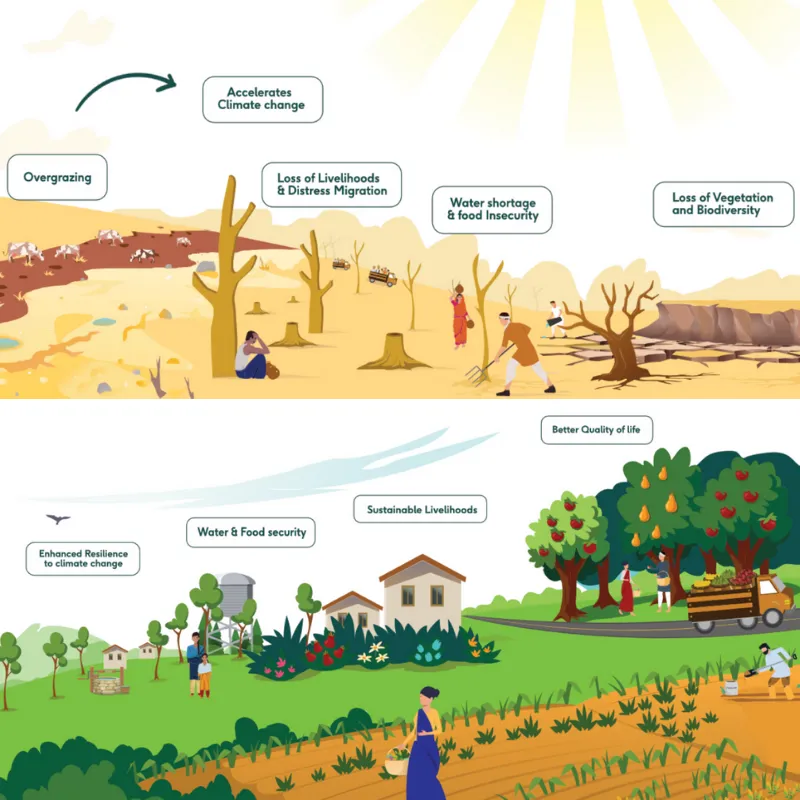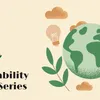Sustaining ecosystems and building livelihoods: How WOTR is addressing rural poverty with watershed development
In this week’s #SustainabilityAgenda series, Watershed Organisation Trusts shares how it has manifested sustainability through rural communities and is empowering them with livelihoods.
In many parts of rural India, areas that are heavily reliant on rains often face water shortage, as ironic as it may seem. During the monsoons, many places may get effective rainfall for a maximum of about 45 days, especially in peninsular India.
Crispino Lobo, Co-founder and Managing Trustee of Watershed Organisation Trust (WOTR) says that in many parts, especially those which are not prone to droughts, the only way to increase the water supplements is to “catch every drop of rain that falls, on the geographies it falls on”.
This can be done through watersheds, which are areas that drain into a specific water body. The rainwater collected in the watersheds feeds water to multiple rivulets of streams, that ultimately join a river.
When these water bodies are located in areas that can flourish with agriculture, it can create a significant impact on the livelihoods around the area.
This thought led Father Hermann Bacher to launch the Indo-German Watershed Management Programme in India in 1989. He wanted to reduce poverty and build a sustainable watershed development programme. Joining him in this mission was Crispino Lobo, who then helped him with the Watershed Organisation Trust (WOTR) in 1993.
Watersheds preserving rain and soil
When it rains, the water runs down the hill and merges into the rivulets that form streams. While a part of it flows into the streams, a part of it goes to other areas of villages and sinks underground to restore the soil moisture, which is essential for the growth of plants and trees.
“The water also replenishes groundwater aquifers, which can be tapped with wells and borewells. While watersheds collect some water on the surface, the main idea is to slow the flow,” Crispino explains.
On the surface, some of the water conservation and storage is done through dams, urban bunds, etc, and other hydraulic structures on the rivers and streams.
Similarly, soil conservation measures start from the top using continuous contour trenches, water absorption trenches, farm bunds, compartment bunds, and other earthen works that control the velocity of the rainwater and prevent the erosion of the soil.

A pictorial representation of the problem that WOTR aims to solve (above) and how the NGO solves it (below) | Image: WOTR
“But to augment these soil and water conservation measures, the hammer effect of rain that causes erosion has to be stopped. This can be effectively done with the help of a vegetative cover. The leaves can break the velocity and the kinetic energy of the rain,” Crispino tells SocialStory.
Some of the water sinks, some of it moves out of the watershed, but effectively, the damage is reduced. So, this water becomes available both for soil, agriculture, and for humans and animals.
Crispino notes that for rural India, this is a great developmental technique as the regions depend largely on rain and agriculture for survival and sustenance.
Watershed Development Organisations Trust
WOTR’s work began in Maharashtra, a rainfed portion of India, where only 16 percent of it is irrigated and one-third of it is considered drought-prone, according to Crispino, who further notes that this is a similar fate for most of the states in the country.
“Our idea was to organise rural communities to trap rainwater across the watersheds they were living in, by regenerating their environments,” he says, adding, “Not only will we improve the quality of life for the people, but also improve agriculture, rural livelihoods and help people break the cycle of poverty.”
But for the development to have an impact at scale, it needed to form a coalition of NGOs, governmental organisations like NABARD (National Bank for Agricultural and Rural Development), and other like-minded thinkers to organise and facilitate rural communities to regenerate environmental spaces.
WOTR was ultimately set up for four reasons – practice and implementation of watersheds, policymaking with decision-makers to upscale the project, and capacity building and knowledge management to research what works and what can be done to improve the communities.
Improving agriculture
So, once their water needs were met, the rural communities look at using watersheds for agriculture.
“We went into agriculture and the whole gamut including land preparation, plant identification, treatment of seeds, planting and cultivation practices, and the cleaning, storage and harvesting of the produce, and including going to market through setting up a farmer producer companies (FPOs),” says Crispino.
But soon, when water was available, certain unsustainable practices emerged. Hundreds of borewells were dug up around a watershed, there was indiscriminate usage for livestock and irrigation, and groundwater was being over-extracted for crops such as sugarcane which have a high requirement.
All this led the communities to go back to square one within five to eight years.
So, unless the demand is managed, the practice was going to continue to be unsustainable. That’s when WOTR also moved to water stewardship, which is creating an attitude and inculcating good behavioural practices in communities to treat water as a valuable and scarce resource.

Farm management practices
The stewardship involves water budgeting, changes in the cropping pattern and crop planning, adoption of new technologies to increase the productivity of water, reducing waste and bridge deficits and putting in place locally defined, managed and enforced rules to ensure that water is used productively and wisely.
This programme has now expanded to hundreds of villages across India, where WOTR creates awareness of sustainable agricultural practices, water conservation and budgeting.
But climate change is becoming an issue of concern. There was variable rainfall which was something that the farmers were not used to over the years. This was affecting the livelihood, and posed a big question of whether the challenge could be overcome.
“So we moved into the area of climate change, adaptation, Water Resources Management, agriculture, adaptation, and biodiversity. Biodiversity is a common thing and in all these areas; we decided to bring together our activities in the framework of what is called ecosystem-based adaptation (EbA),” says Crispino.
With several ecosystems such as wetlands, drylands and others, WOTR addresses the challenges of climate change as well as the food, nutrition, and income security needs of a community. All the interventions of the organisation are brought together under this EbA.
Women empowerment and livelihoods
Cross-cutting cross all these interventions is the focus on women's empowerment, the development of institutions, and governance and capacity building.
“80 percent of agricultural work is done by women and people in rural India. For their livelihoods, rural households depend on resources from the local environment. So, if the environment thrives, the community thrives,” says Crispino.

A woman digging bunds
“So, indirectly, women hold the key to regenerating the environment and managing it sustainably,” he adds.
Aligning with their women empowerment motive, WOTR has directly and in partnership with others organised, trained and facilitated over 10,200 women Self Help Groups (SHGs) involving around 125,000 women.
“We also promote a lot of farm and non-farm based enterprises and livelihoods such as tailoring, processing of foods, welding shops, kiranas, poultry, and dairy. These enable people to earn money as a supplement to the main agricultural income, or even as an independent business,” says Crispino.
Impact and the way forward
Bhojdari is a village in the Sangamner block of Ahmednagar district in Maharashtra, India and receives relatively less rainfall of around 550mm in a year, making it drought-prone.
Home to a large section of socio-economically marginalised communities, Bhojdari faces several challenges, and unpredictable climatic events have only worsened the situation.
However, with three major projects in the village since 1996, WOTR helped the communities in the village improve communities’ adaptive capacities, ecosystems and biodiversity, and participatory governance.
Thanks to the efforts of WOTR, the forest cover has increased by 43 percent, the surface water storage capacity increased by 87 percent.
Pushpa Vikas Hande, a young woman resident of Bhojdari and an active member of the Village Water Management team, says, “Our village has enough left over after using water for crops across two and at times even three seasons, for domestic use and for their animals. Thanks to water budgeting, our village no longer faces water scarcity like other villages in the state.”

Bhojdari (before and after)
Over the 28 years of its existence, they have reached more than seven states, 3,754 villages, with 3.8 million beneficiaries, and has trained over 4.19 lakh people in their initiatives.
The team has over 240 people who are working professionals, including agriculture engineers, surface hydrologists, underground water specialists, irrigation engineers, agronomists, IT, environmentalists, and managers.
This widespread work of the NGO was supported by grants, government institutions like NABARD, individual donations, and CSR. Some of the funding partners include Nalanda Foundation, RBS Foundation, Tata Steel Foundation, among many others.
On the road ahead, Crispino says that they want to expand to a total of 10 states in the coming years and also reach out internationally, particularly in Africa.
“We want to deepen our engagement in the applied research field, as well as enter this the world of skilling and employment generation for rural people,” he says.
He adds, “The whole employment space has changed due to the COVID-19 situation, there is a whole new work dynamic coming up. So, we would like to work and see how we can set up such a skilling, educational, and advanced research and training educational institution for employment generation.”
Edited by Kanishk Singh









